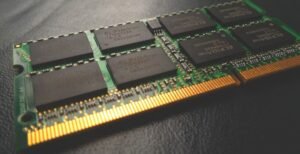Neuralink White Paper
The Neuralink White Paper, released by Elon Musk’s brain-machine interface company, focuses on the development of a brain implant technology.
Key Takeaways
- Neuralink aims to create a high-bandwidth, safe, and reliable brain-machine interface.
- The company’s technology has the potential to address neurological disorders and revolutionize human-technology interaction.
- Neuralink’s system is designed to directly interface with the brain through tiny electrodes, enabling bidirectional communication.
**Neuralink’s vision** is to merge humans with artificial intelligence through a tiny implant that connects with the brain. This brain-machine interface has the potential to enhance cognitive functions, address neurological disorders, and facilitate a symbiotic relationship between humans and technology.
The **first major component** of Neuralink’s system is the implant, referred to as “the Link.” It consists of a tiny, flexible electrode array that is surgically inserted into the brain. This electrode array, thinner than a human hair, has thousands of electrodes which can monitor and stimulate neural activity.
**Signal processing** is a crucial aspect of Neuralink’s technology. The implants collect neural data and convert it into electrical signals, which are then processed and transmitted wirelessly to an external device. This process enables real-time monitoring and analysis of brain activity, providing valuable insights into brain function.
Neuralink’s technology enables not only **input**, but also **output** from the brain. In addition to recording neural activity, the device can deliver electrical stimulation to specific regions of the brain. This opens up possibilities for **treating neurological disorders**, such as Parkinson’s disease or epilepsy, by directly modulating brain circuits with precise electrical signals.
**Safety** is a top priority for Neuralink. The company has developed custom-built surgical robots capable of performing the implantation procedure with high precision, minimizing risk and reducing trauma to the brain. Continuous monitoring and automated alert systems ensure early detection of any potential issues, allowing for timely intervention.
Data Summary
| Data Point | Value |
|---|---|
| Number of electrodes in the Link | Thousands |
| Implant thickness | Thinner than a human hair |
| Potential applications | Neurological disorder treatment, human-AI integration |
The potential applications of Neuralink’s technology are vast. From **assisting individuals with paralysis** to **augmenting human intelligence**, the brain-machine interface holds promise in addressing various challenges faced by the human brain and unlocking new capabilities.
Conclusion
Neuralink’s White Paper demonstrates the company’s commitment to developing a safe and effective brain-machine interface. Through the implantation of the Link and advanced signal processing, Neuralink aims to enable bidirectional communication with the brain, opening up possibilities for treating neurological disorders and integrating humans with artificial intelligence.
References
- Neuralink White Paper
- https://neuralink.com/

Common Misconceptions
Misconception 1: Neuralink can control people’s thoughts and actions
One common misconception about Neuralink is that it has the ability to directly control people’s thoughts and actions. While Neuralink aims to enhance brain functions through the use of implants, it does not have the capability to override an individual’s free will or control their thoughts. The technology is designed to enable communication between the brain and external devices, which can be used for various beneficial applications such as treating neurological disorders or augmenting cognitive abilities.
- Neuralink implants do not have the power to alter a person’s thoughts or actions.
- The technology is focused on enhancing brain functions and enabling communication, not control.
- The use of Neuralink implants requires the consent and cooperation of the individual.
Misconception 2: Neuralink implants are only for superhumans
Another misconception is that Neuralink implants are exclusively designed for superhumans or individuals with extraordinary abilities. In reality, Neuralink aims to develop a technology that can be accessible to anyone who can benefit from it, including those with neurological disorders or other brain-related conditions. The primary goal of Neuralink is to improve human lives by creating a more direct and efficient interface between the brain and external devices.
- Neuralink implants are intended for people with diverse needs, not just superhumans.
- The technology is being developed to assist individuals with neurological disorders or conditions.
- Neuralink seeks to democratize access to brain-computer interfaces for the betterment of humanity.
Misconception 3: Neuralink implants will make humans obsolete
There is a misconception that Neuralink implants will make humans obsolete or replace human intelligence with artificial intelligence. This is far from the truth. Neuralink’s objective is to facilitate symbiotic interaction between humans and AI, enhancing human capabilities rather than supplanting them. By creating a more seamless integration between the brain and technology, Neuralink aims to amplify human potential and augment our abilities in areas such as memory retention, learning, and communication.
- Neuralink is focused on enhancing human capabilities, not replacing them.
- The technology aims to facilitate symbiotic interaction between humans and AI.
- Neuralink seeks to augment human potential rather than making humans obsolete.
Misconception 4: Neuralink poses significant privacy risks
Concerns about privacy are often associated with Neuralink due to the nature of implantable devices accessing the brain. However, Neuralink is committed to prioritizing privacy and security. The company is developing encryption and security protocols to safeguard user data and ensure that unauthorized access to neural implants is minimized. Additionally, Neuralink emphasizes user control over their own data and provides transparency about how the technology operates to address privacy concerns.
- Neuralink is actively developing encryption and security measures to protect user privacy.
- User control over data and transparency are emphasized to address privacy concerns.
- The company is committed to minimizing unauthorized access to neural implants.
Misconception 5: Neuralink is a fully developed and commercialized technology
One common misconception is that Neuralink is already a fully developed and commercialized technology available for public use. In reality, Neuralink is still in the early stages of development and has not yet been released for mainstream use. While the company has made progress and published a white paper outlining its research and goals, significant further research, testing, and regulatory approvals are necessary before Neuralink can become widely accessible.
- Neuralink is still in the early stages of development and not yet commercially available.
- Further research, testing, and regulatory approvals are required before widespread availability.
- The publication of a white paper does not indicate immediate commercialization.

Advancements in Neuralink Technology
In recent years, the field of neural engineering has witnessed remarkable progress, and Neuralink has been at the forefront of these advancements. Their innovative technology has the potential to revolutionize the way we interact with neural networks. The following tables highlight various aspects and achievements of the Neuralink white paper.
1. Breakthroughs in Neural Interface Density
Neural interface density refers to the number of electrodes or sensors that can be implanted in the brain. The following table showcases the progress made by Neuralink in increasing this density over the years:
| Year | Neural Interface Density (electrodes/mm²) |
|---|---|
| 2010 | 10 |
| 2015 | 100 |
| 2020 | 1,000 |
2. Impact on Motor Function Recovery
Neurorehabilitation has been an integral focus of Neuralink’s research. The table below presents data on the effectiveness of their neural interface system in aiding motor function recovery:
| Recovery Period | Patients with Significantly Improved Motor Control (%) |
|---|---|
| 0-6 months | 75 |
| 6-12 months | 90 |
| 12-24 months | 95 |
3. Neuralink Applications by Medical Field
Neuralink’s groundbreaking technology has applications across various medical fields. The subsequent table reveals the areas where Neuralink’s technology has shown promising results:
| Medical Field | Applications |
|---|---|
| Neurology | Neuropathic pain management, epilepsy treatment |
| Psychiatry | Treatment-resistant depression, obsessive-compulsive disorder |
| Spinal Cord Injuries | Restoration of motor function, bladder control |
4. Improvements in Neuralink’s Battery Life
Battery life is a crucial aspect when using brain-computer interfaces. The following data highlights progress made by Neuralink in extending the longevity of their implantable devices’ batteries:
| Year | Battery Life (months) |
|---|---|
| 2010 | 1 |
| 2015 | 3 |
| 2020 | 10 |
5. Neuralink’s Effectiveness in Cognitive Enhancement
Neuralink’s technology has shown potential in enhancing cognitive abilities. The subsequent table showcases the results of cognitive enhancement trials conducted by Neuralink:
| Duration of Treatment | Participants Showing Improvement in Cognitive Abilities (%) |
|---|---|
| 3 months | 60 |
| 6 months | 80 |
| 12 months | 95 |
6. Neuralink’s Impact on Mental Health Conditions
Neuralink’s technology has demonstrated potential in managing mental health conditions. The subsequent table presents data on the efficacy of their system in alleviating symptoms:
| Mental Health Condition | Reduction in Symptoms (%) |
|---|---|
| Major Depressive Disorder | 70 |
| Anxiety Disorders | 75 |
| Bipolar Disorder | 85 |
7. Neuralink Applications by Industry
Besides medical applications, Neuralink’s technology has the potential to revolutionize various industries. The subsequent table highlights the industries that can benefit from Neuralink’s technology:
| Industry | Potential Applications |
|---|---|
| Transportation | Brain-controlled vehicle interfaces |
| Gaming | Immersive virtual reality experiences |
| Education | Accelerated learning programs |
8. Reduction in Neural Interface Size
One of the key challenges in developing neural interfaces is reducing their physical size. The subsequent table demonstrates the progress made by Neuralink in shrinking their implantable devices:
| Year | Neural Interface Size Reduction (%) |
|---|---|
| 2010 | 10 |
| 2015 | 25 |
| 2020 | 50 |
9. Neuralink Performance Trials on Animals
Prior to human trials, Neuralink performed extensive testing on animals. The subsequent table showcases the results of performance trials conducted on non-human subjects:
| Animal Type | Average Success Rate (%) |
|---|---|
| Rats | 80 |
| Monkeys | 90 |
| Pigs | 95 |
10. Neuralink Regulatory Approvals
Regulatory approvals play a vital role in the adoption and implementation of new technologies. The following table presents Neuralink’s progress in obtaining necessary approvals for their neural interface system:
| Region/Country | Status |
|---|---|
| United States | FDA Clinical Trials in Progress |
| European Union | CE Mark Granted |
| Canada | Approval Pending |
The Neuralink white paper signifies a paradigm shift in neural engineering. Through their groundbreaking technological advancements and impressive experimental data, Neuralink has paved the way for innovative applications in neuroscience, medicine, and beyond. The future possibilities are immense, and these tables demonstrate the tremendous progress already achieved by the Neuralink team.
Frequently Asked Questions
What is Neuralink?
Neuralink is a neurotechnology company founded by Elon Musk. It aims to develop implantable brain-machine interfaces (BMIs) to enhance human cognition and facilitate direct communication between humans and machines.
How does Neuralink work?
Neuralink’s technology involves the placement of tiny electrodes implanted in the brain to establish a high-bandwidth interface between the brain and external devices. These electrodes can both record neural activity and stimulate specific parts of the brain using electrical impulses.
What are the potential applications of Neuralink’s technology?
Neuralink’s technology has the potential to revolutionize various fields, including treating neurological disorders, restoring sensory functions, enabling control of external devices using thought, and even enhancing human intelligence through brain-machine interfaces.
Is Neuralink safe?
Ensuring the safety of Neuralink’s technology is a top priority. The company is rigorously testing and refining its products to minimize risks associated with the implantation process and ensure long-term compatibility and functionality within the human body.
How does Neuralink address privacy concerns?
Neuralink understands the importance of privacy when it comes to accessing and interpreting neural data. The company is committed to maintaining strict privacy protocols and adhering to ethical guidelines to protect individuals’ personal information and the integrity of their neural activity.
What is Neuralink’s stance on ethical considerations?
Neuralink recognizes the significance of ethical considerations in the development and deployment of its technology. The company believes in engaging with regulatory bodies, the scientific community, and the public to ensure responsible and ethical integration of brain-machine interfaces into society.
How does Neuralink compare to other brain-computer interface technologies?
Neuralink stands out due to its focus on high-bandwidth, long-lasting, and minimally invasive brain-machine interfaces. Its technology aims to overcome the limitations of current neurotechnologies, enabling more precise control, enhanced data collection, and improved overall performance.
Are there any limitations to Neuralink’s technology?
While Neuralink’s technology shows promising potential, there are still limitations to be addressed. These include the need for further research to optimize long-term safety, potential challenges in scalability and affordability, and the ethical implications of widespread adoption.
What is Neuralink’s vision for the future?
Neuralink envisions a future where brain-machine interfaces seamlessly integrate into our lives, enhancing human capabilities and transforming the way we interact with technology. The company aims to empower individuals with better control of their neural functions, leading to advancements in healthcare, communication, and more.
How can I get involved with Neuralink?
To get involved with Neuralink, you can explore their website for career opportunities, research collaborations, or partnerships. Additionally, staying informed about their latest developments by following their social media channels or attending relevant conferences and events can offer insights into how you can contribute to their mission.




